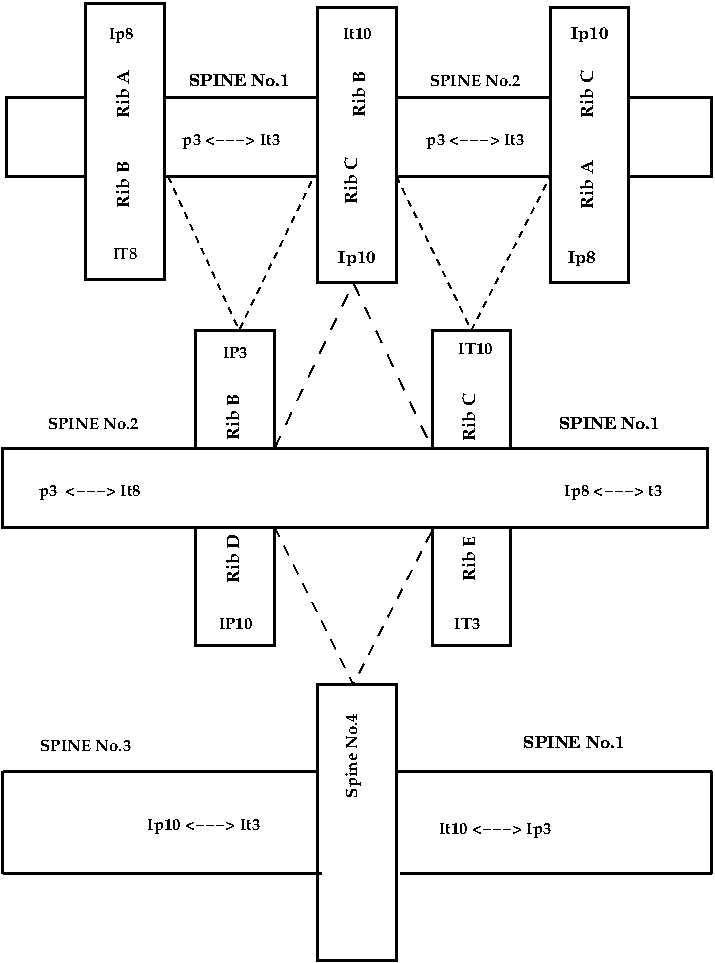This piece can be performed as multi-phonic media or as a tele-performance composition with mallet instruments on the other ends. This is a composition searching for symmetries on atonal axes and structure, -a serial take by the composer.- It borrows two rows from Luigi Dallapicola in order to cast eight hexachords given by two transpositions on their prime form and inversions. Each hexachord is an element, source for ideas, and “grungestalt” for the piece. Combinations of hexachords delineate symmetries, either vertically or horizontally but they also gather to form chordal sequences.
On its structure Yapaya draws upon three horizontal spines and one vertical, each one making use of each of hexachords from each row. Spines are sequences arranged in combinations of patterns that might follow a straight order of notes for each hexachord or variations like rotations whereby there is and exchange of the starting note. Further in, there are ribs overlapping spines on the time domain consisting on substructures coming from the original hexachords . Ribs are used to counterpoint spines with smaller sound events. Overall form of this piece is binary with part[a] and part[b] and part[c] combination of part[a] and part[b]. Spine#1 is contained in part[a], spine#2 in part[b] and spine#3 in part[c]. Spine#4 is a sequence and variations of vertical hexachords counterpointing other spines.
Most modeling for Yapaya is the result of computer assisted composition. Several Lisp functions provide algorithms for manipulations of the original rows, focusing on transpositions of the prime form as inversions and extracting of hexachords. Further programming has provided permutations and combinations for sequential positions of structures to achieve symmetrical ordering for spines and ribs. Rhythmic combinations follow similar directives though applied to duration in seconds function of tempo. To our fortune Common Music (CMv2) has builtin functionality for dealing with sequences of notes (in this case hexachords ) and rhythmic duration. In CM sequences can take the form of patterns for note events. Furthermore symmetrical combinations of hexachords can take the form of a pattern. -More on symmetry below.-
Following structure of the piece, spine#1 is based on hexachords from P3 et IP3 and T3 et IT3, where “P” is prime form of tone-row No.1, and “T” of tone-row No.2. “I” is the inversion of the original row, and “3” its third transposition. Spine#2 frames hexachords from P3 et IP8 plus T3 et IT8. Spine#3 is a sequence and counterpoint of hexachords from IP3 et IP10. There are four patterns of (4/4) time signature measures, as well other four using (3/4) form rhythmic measures. Horizontal textures are combinations of left hand hexachords and right handed, looking for symmetries. Symmetry on this case is defined as in the analogy of a floor with black and white square tiles. For musical purpose, a tile is either a left hand hexachord or right hand hexachord . Recall that there are eight hexachords being used on this piece, four left hand and four right hand. Symmetrical patterns depend on the position and exchange of each hexachord consequently creating a huge set of patterns coming out just by interchanging different kinds of permutations. Only constrain for this arrangement is to avoid a direct succession of l-hand and r-hand hexachords so that original 12-tone-row will never be revealed implicitly. Similarly patterns resulting of measures with series of rhythmic duration behave just like symmetrical perception of tiles.

SKETCH No.1: symmetrical structure and patterns on Yapaya
Each candidate for a spine comprises counterpoint within two horizontal symmetries, thereby achieving fugal relationships among them either by atonal content or by rhythmic contrast. Hexachords are performed in their original sequence of notes but on occasion they can be palindromic or a rotation of their starting notes. Ribs cross and overlap spines delineating vertical textures and chords to the ear. Since spine#1 is formed using hexachords of P3 or T3, ribs overlapping this spine can contain hexachords of PI10 et TI10 as well as those of PI8 et TI8. Same is true for spine#2 and #3, although avoiding P3 and T3. Remember spine#4 is a succession of vertical chords and can be overlapped by ribs of any type of hexachord.
Listen to the first part (SPINE No.1 and its components) from "YapaYa":
✇ Listen 🗧
... UHJ Ambisonics down mix of: First section of `` Yapaya''